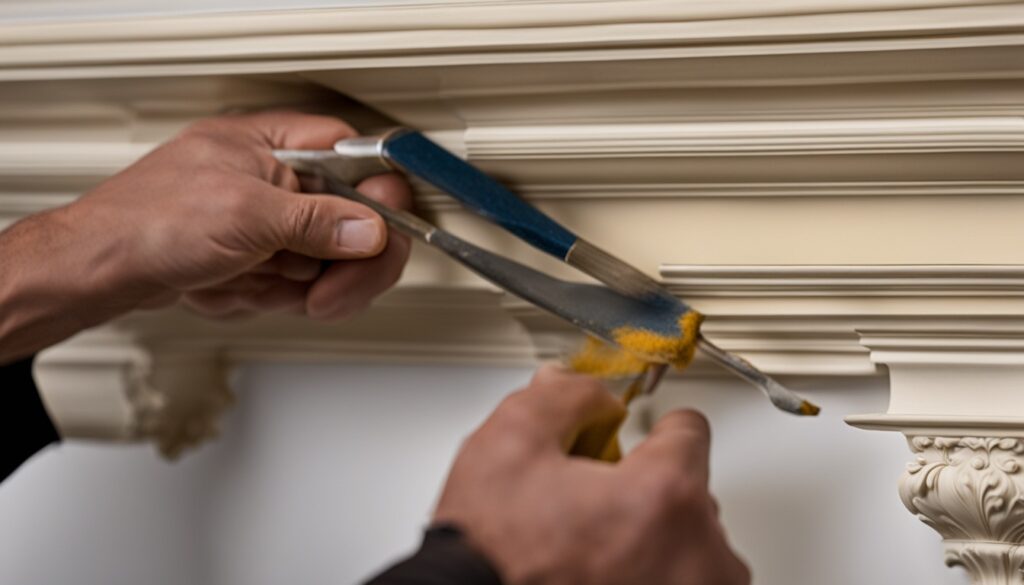
Painting trim is both precise and skillful. It is key to a room’s overall style. By using specific techniques, painters make sure a room’s details shine. This piece will examine how these detailed works are managed in homes and offices.
Trim painting is about details and the right tools. Painters work carefully around corners and fancy designs. Doing this the right way can really spruce up a room. We will discuss the steps professionals take for perfect trim work.
Key Takeaways
- Trim painting requires specialized skills and tools
- Proper preparation is crucial for a smooth finish
- Different techniques are used for various trim types
- Quality materials ensure long-lasting results
- Attention to detail sets professional work apart
Understanding the Importance of Detailed Trim Work
Trim work really shapes a room’s feel. It’s more than just fixing gaps or hiding flaws. Trim adds depth, style, and shine to your home. Let’s see how it boosts your home’s design inside.
Enhancing Room Aesthetics with Trim Painting
Painting trim changes a room’s look a lot. A new coat on baseboards or window frames can make a room pop. It adds interest to the walls and makes the room feel complete. Think of it as framing a lovely picture.

The Role of Trim in Interior Design
Trim is a big deal in design. It joins different parts of a room to make it all match. A good trim can make a room feel just right.
It does this by:
- Defining transitions between walls and floors
- Pointing out special parts of the design
- Adding character to simple spaces
- Creating visual balance all around
Designers use trim to make a room look stand out, no matter the style. Take a moment to read this awe-inspiring article.
Common Types of Interior Trim
Various trims have different roles. Here are some types you might see:
- Baseboards: They keep walls safe and hide floor gaps.
- Crown molding: It makes the ceiling and walls meet in style.
- Window casings: They make windows look good and hide gaps.
- Door trim: Frames doors, making them look better and smoother.
- Chair rails: They stop chairs from hurting walls and look nice too.
Every trim type helps a room look complete and polished.
Preparation Techniques for Trim Painting
Getting the trim ready is key for a perfect paint job. Follow these essential steps for great-looking trim.
Surface Cleaning and Sanding
First, clean the surface well to get rid of dirt. Use water with a little detergent and a soft cloth. Then, sand the trim when it’s dry to make it smooth for paint. How you sand depends on the type of trim:
- On flat surfaces, a sanding block with fine-grit sandpaper is best
- Wrap sandpaper around a foam pad for curves
- Use sanding sponges on detailed spots
Applying Primer and Choosing the Right Paint
Primer is crucial for a paint job that lasts. Pick primer that fits your trim. Apply it smoothly with a brush or roller, and let it dry well. When choosing paint, think about:
- How easy it is to clean, like semi-gloss or high-gloss finishes
- Oil-based paints for strength or water-based for drying fast
- Choosing colors that work well with your walls
Masking and Protecting Adjacent Surfaces
To keep your painting neat, protect the area around the trim. Use painter’s tape carefully on walls, floors, and ceilings. Also, put drop cloths on furniture close by. Tape off hardware and glass on windows and doors. This helps avoid messy paint accidents and makes your work look professional.
Follow these steps for trim prep to set the stage for a stunning paint job. You’ll improve your home’s look inside with these simple tips.
Trim Painting (This directly relates to the specific service of painting trim)
Trim painting is key to how a room looks. Pros have special ways to do it perfectly. Let’s dive into what makes this service stand out.
Choosing the right brush is step one. Angled sash brushes help in corners and edges. A 2-inch brush is great for bigger areas. Use a synthetic brush with latex paint and a natural one with oil paint.
Here’s how the pros put on the paint:
- Load the brush with paint, tapping off excess
- Start in the middle of the trim piece
- Use long, smooth strokes
- Blend your strokes well
- Wait for each coat to dry fully before adding the next
Follow these tips for the finest trim painting:
- Paint trim first, and you can touch up walls easier
- Use painter’s tape for sharp lines
- Put on thin layers to avoid drips
- Sand between coats to make it smooth
- Go for semi-gloss or high-gloss for strong paint
Getting good at trim painting takes time. Sometimes it’s best to bring in the pros. The right trim job can really boost your room’s style.
Advanced Techniques for Detailed Trim Work
Getting good at trim painting makes any room look better. You can spray paint trim or do detailed work. Let’s look at the best ways to paint trim perfectly.
Brushing vs. Spraying Methods
Deciding how to paint trim is important. Brushing is great for precise jobs. But if you want a smooth look, spraying is better. Think about what your project needs:
- Brushing: Ideal for small areas and touch-ups
- Spraying: Perfect for large surfaces and uniform coverage
- Combo: Use both for best results on complex trim designs
Dealing with Intricate Moldings and Carvings
Working on detailed moldings takes time and care.
- Use fine-tipped brushes for crevices
- Apply thin, multiple coats to keep the details
- Consider gel stains for deep grooves
Achieving Smooth Finishes on Different Trim Materials
Getting a smooth finish depends on the trim’s material. Wood, MDF, and PVC need different steps. Sand wood between coats and prime well. MDF should be sealed first. And PVC often requires special primers for the paint to stick.
Keep trying, and you’ll learn these advanced techniques. Test out different tools and ways. In time, you’ll make the perfect trim that makes any room beautiful.
Quality Control and Finishing Touches in Trim Painting
Trim painting quality control is key for a polished room. Professional painters scrutinize each step. This means checking the smoothness of the paint, its even cover, and sharp edges where the trim meets the walls.
Finishing touches greatly affect how the trim looks. These methods may include sanding between each coat. Painters also apply paint in thin layers to ensure it looks good. Touch-ups are done to fix any small mistakes. Skilled painters make these repairs blend in smoothly with the rest.
The last check involves looking at the trim in different lights. This is to catch any missed spots or irregularities. Painters use special tools to measure the paint’s thickness and how well it sticks. Their goal is to make the room look perfect.
At Painting Done by Angels, we are passionate about helping those in the Scottsdale & Phoenix, Arizona, area make their homes and businesses beautiful. We provide high-quality interior and exterior painting services with 15+ years of expertise. We take great pride in providing the finest results for customers every time! We are licensed, bonded, and insured so that your investment is secure with us; We pay close attention to delivering the finest outcomes for our customers each time!
